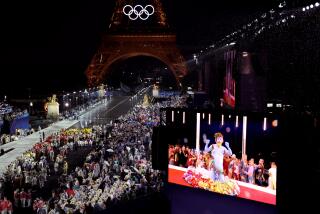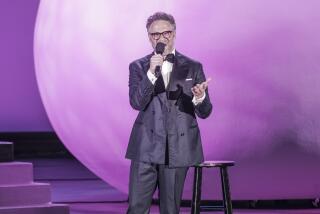The Economic Summit Ends With Tea but Not With a Toast
- Share via
TOKYO — It was the biggest power dinner since President Reagan broke bread with Soviet leader Mikhail Gorbachev in Geneva last November.
Leaders of the seven largest industrial democracies, along with some of their spouses, attended a formal state banquet hosted by the rarely seen Japanese Emperor Hirohito on Tuesday night at the Imperial Palace, wrapping up the 12th annual economic summit.
Staying Off Everyone’s Toes
With that many giant egos packed into one palace, extraordinary care was taken not to offend any of them. There were no toasts, according to one palace official, because it would have been touchy to figure out who had the right to go first.
Even the beverage list, which required the placing of five wine glasses at each setting, was designed to glorify the seven guests of honor. (The Emperor does not drink alcoholic beverages, but not all the drinks contained alcohol.)
There was sake in salute to Japanese Prime Minister Yasuhiro Nakasone and his wife, Tsutako; Italian vermouth for Prime Minister Bettino Craxi and his wife, Anna; Bernkasteler Doktor 1982 for German Chancellor Helmut Kohl and his wife, Hannelore; Canadian Crown Royal whisky for Prime Minister Brian Mulroney and his wife, Mila; Beefeater gin and tonics for British Prime Minister Margaret Thatcher, Dom Perignon champagne 1976 for French President Francois Mitterrand, and for President Reagan and his wife, Nancy, fresh juice from California Sunkist oranges.
With all the wine produced in California, orange juice may sound like a strange choice. But Japan has been resisting pressure to place U.S. wines on the agenda of trade talks. And Sunkist oranges are considered quite a luxury here, costing about $1 each and $6 for a glass of juice in a downtown hotel.
It was pouring rain as, one by one, the seven motorcades with their attendant police escorts pulled up outside the palace. Guests were greeted inside the sliding glass front doors by Crown Prince Akihito, who was assisted by the palace protocol chief, Isao Abe.
Between the entrances of Mitterrand and French Prime Minister Jacques Chirac, two men wearing street clothes and carrying shopping bags walked in, unidentified to the press.
Then came Chirac, who let out a big “Oh!” when turning to the prince, apparently having just mistaken the protocol chief for the prince.
The palace itself is stark and modern, with a giant teak staircase and translucent paper shoji screens separating the vestibule where the guests arrived from the rest of the palace.
Officials and Members
Many high-level government officials and members of the Japanese Imperial family attended the dinner, although the emperor’s wife of 62 years, Empress Nagako, is often in poor health and was not able to be there.
Among the guests were Secretary of State George Shultz, Treasury Secretary James Baker, and former Japanese Prime Ministers Zenko Suzuki and Takeo Fukuda.
The 85-year-old emperor, who just celebrated his 60th year on the Chrysanthemum Throne, is seldom seen or even heard from in Japan. He is said to prefer working in his laboratory, having written at least nine books on marine biology and having discovered a type of Pacific crustacean that was named after him.
It made big news when Hirohito gave an interview to Japanese reporters April 15, telling them that World War II was “the most distasteful” experience of his reign and that Japan’s ensuing recovery was “the happiest.”
On this evening, Hirohito treated his guests to a dinner of swallow’s nest soup, fish stewed in sake, roast leg of lamb, salad, Mount Fuji ice cream and a dessert of melon and strawberries.
Earlier in the day, several of the first ladies attended a Japanese tea ceremony, a 500-year-old tradition that is reputed to bring about spiritual discipline and harmony.
Hosted by Tsutako Nakasone, the tea enabled Nancy Reagan, Anna Craxi, Mila Mulroney and Hannalore Kohl to participate in the ceremony while learning about it.
The women entered the Urasenke Tea House, normally used as a school for tea students, from a garden path, leaving their shoes at the door.
Inside they found straw tatami mats on the floor, but they did not have to kneel on the floor, as is normally the custom. There was a table set for them.
Finding a Clean Soul
As the process was explained to them, the tea master went about the highly ritualized way of making the tea, looking first into the dipper to see if his soul was clean enough to make the tea.
Each woman was served separately, Mrs. Reagan going second, after Mrs. Nakasone.
There are strict rules of etiquette surrounding the tea ceremony, including the practice of turning the bowl clockwise about 180 degrees before drinking from it.
Apparently Mrs. Reagan was either given the wrong instructions or misunderstood what she was supposed to do, for instead of turning the bowl, she shook it back and forth. All the other women turned their bowls.
Turning the bowl “is a matter of humbleness and courtesy,” said Gretchen Mittwer, a former Los Angeles resident who has lived in Japan the last five years and is editor of a quarterly journal about the tea tradition.
If a foreigner attends a tea ceremony, he or she would turn the bowl “if he or she happens to know it’s the thing to do,” Mittwer said.
” . . . It is recognized that if you are not familiar with certain teachings and regulations that tea pupils have learned in years of study, that the procedure is not automatically understood. The host would not think badly about it. It’s not a terrible thing.”
The tea was followed by a lunch of hors d’oeuvres, consomme soup of turtle with egg tofu, sushi and steamed abalone, deep-fried prawns, simmered eggplant with miso sauce, charcoal barbecued prime beef, steamed rice with scallops, Japanese pickles and fruits.
More to Read
Sign up for Essential California
The most important California stories and recommendations in your inbox every morning.
You may occasionally receive promotional content from the Los Angeles Times.










